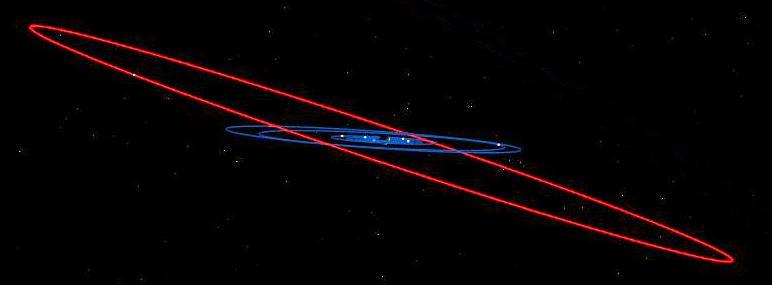Clyde Tombaugh (1906-1997) spent the first fifteen years of his life on a farm near Streator, Illinois, and then his family moved to a farm near Burdett, Kansas (no wonder he got interested in astronomy!), and he went to high school there. Then, on February 18, 1930, Tombaugh, a self-taught amateur astronomer and telescope maker, discovered the ninth planet in our solar system, Pluto. It had been nearly 84 years since the eighth planet, Neptune, had been discovered, in 1846. And it would be another 62 years before another trans-Neptunian object (TNO) would be discovered.
Clyde Tombaugh made his discovery using a 13-inch f/5.3 photographic refractor at the Lowell Observatory in Flagstaff, Arizona.
Clyde Tombaugh was 24 years old when he discovered Pluto. He died in 1997 at the age of 90 (almost 91). I was very fortunate to meet Prof. Tombaugh at a lecture he gave at Iowa State University in 1990. At that lecture, he told a fascinating story about the discovery of Pluto, and I remember well his comment that he felt certain that no “tenth planet” larger than Pluto exists in our solar system, because of the thorough searches he and others had done since his discovery of Pluto. But, those searches were done before the CCD revolution, and just two years later, the first TNO outside the Pluto-Charon system, 15760 Albion (1992 QB1), would be discovered by David Jewitt (1958-) and Jane Luu (1963-), although only 1/9th the size of Pluto.
Pluto is, by far, the smallest of the nine planets. At only 2,377 km across, Pluto is only 2/3 the size of our Moon! Pluto has a large moon called Charon (pronounced SHAR-on) that is 1,212 km across (over half the size of Pluto), discovered in 1978 by James Christy (1938-). Two additional moons were discovered using the Hubble Space Telescope (HST) in 2005: Hydra (50.9 × 36.1 × 30.9 km) and Nix (49.8 × 33.2 × 31.1 km). A fourth moon was discovered using HST in 2011: Kerberos (10 × 9 × 9 km). And a fifth moon, again using HST, in 2012: Styx (16 × 9 × 8 km).
Pluto has been visited by a single spacecraft. New Horizons passed 12,472 km from Pluto and 28,858 km from Charon on July 14, 2015. Then, about 3½ years later, New Horizons passed 3,538 km from 486958 Arrokoth, on January 1, 2019.
Only one other TNO comparable in size to Pluto (or larger) is known to exist. 136199 Eris and its moon Dysnomia were discovered in 2005 by Mike Brown (1965-), Chad Trujillo (1973-), and David Rabinowitz (1960-). It is currently estimated that Eris is 97.9% the size of Pluto. Not surprisingly, in 2006 Pluto was “demoted” by the IAU from planethood to dwarf planet status. (Is not a “dwarf planet” a planet? Confusing…)
My take on this is that Pluto should be considered a planet along with Eris, of course. The definition of “planet” is really rather arbitrary, so given that Pluto was discovered 75 years before Eris, and 62 years before TNO #2, I think we should (in deference to the memory of Mr. Tombaugh, mostly) define a planet as any non-satellite object orbiting the Sun that is around the size of Pluto or larger. So, by my definition, there are currently ten known planets in our solar system. Is that really too many to keep track of?
There is precedent for including history in scientific naming decisions. William Herschel (1738-1822) is thought to have coined the term “planetary nebula” in the 1780s, and though we now know they have nothing to do with planets (unless their morphology is affected by orbiting planets), we still use the term “planetary nebula” to describe them today.
In the table below, you will find the eight “classical” planets, plus the five largest TNOs, all listed in order of descending size. (The largest asteroid, Ceres, is 939 km across, and is thus smaller than the smallest of these TNOs.)
You’ll see that the next largest TNO after Eris is Haumea, and that its diameter is only 67% that of Eris.
I’ve also listed the largest satellite for each of these objects. Venus and Mercury do not have a satellite—at least not at the present time.
It is amazing to note that both Ganymede and Titan are larger than the planet Mercury! And Ganymede, Titan, the Moon, and Triton are all larger than Pluto.
Largest Objects in the Solar System
| Object | Diameter (km) | Largest Satellite | Diameter (km) | Size Ratio |
| Jupiter | 139,822 | Ganymede | 5,268 | 3.8% |
| Saturn | 116,464 | Titan | 5,149 | 4.4% |
| Uranus | 50,724 | Titania | 1,577 | 3.1% |
| Neptune | 49,244 | Triton | 2,707 | 5.5% |
| Earth | 12,742 | Moon | 3,475 | 27.3% |
| Venus | 12,104 | N/A | N/A | N/A |
| Mars | 6,779 | Phobos | 23 | 0.3% |
| Mercury | 4,879 | N/A | N/A | N/A |
| Pluto | 2,377 | Charon | 1,212 | 51.0% |
| Eris | 2,326 | Dysnomia | 700 | 30.1% |
| Haumea | 1,560 | Hiʻiaka | 320 | 20.5% |
| Makemake | 1,430 | S/2015 (136472) | 175 | 12.2% |
| Gonggong | 1,230 | Xiangliu | 200 | 16.3% |
Should any other non-satellite objects with a diameter of at least 2,000 km be discovered in our solar system, I think we should call them planets, too.



















